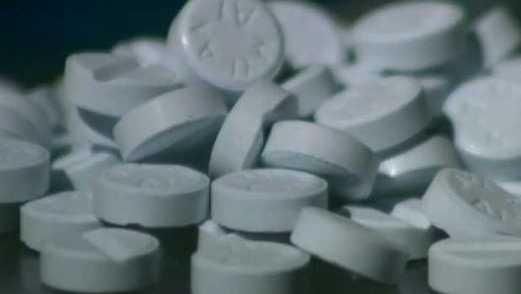
Fentanyl: Emergency Responders at Risk
Preventing Emergency Responders’ Exposures to Illicit Drugs
Responders are likely to come into contact with a mixture of illicit drugs during routine job duties. These mixtures of illicit drugs can include cocaine, methamphetamines, cannabinoids, cathinones, and opioids such as fentanyl and heroin for example. Exposure* to illicit drugs can be harmful. Although the components of illicit drug mixtures might not be known at the time, emergency responders can use the following information to learn about safe operating procedures, and proper use of personal protective equipment (PPE) when responding to incidents that may involve illicit drugs.Key Recommendations
NIOSH offers the following recommendations to help prevent emergency responders’ exposures to illicit drugs, including fentanyl:
- Always wear nitrile gloves when illicit drugs may be present and change them properly when they become contaminated.
- Wear respiratory protection if powdered illicit drugs are visible or suspected.
- Avoid performing tasks or operations that may cause illicit drugs to become airborne.
- Do not touch the eyes, nose, or mouth after touching any surface that may be contaminated, even if wearing gloves.
- Wash hands with soap and water after working in an area that may be contaminated, even if gloves were worn. Do not use hand sanitizer or bleach.
- Take training on and follow NIOSH’s recommended Standard Safe Operation Procedures below.
Standard Safe Operating Procedures
What work practices should emergency responders follow?
Responders should follow their department’s established work practices as well as these recommendations when illicit drugs are known or suspected to be present.- When arriving at a scene, responders should:
- Analyze the incident
- Determine if illicit drugs and/or other hazards may be present.
- Do not eat, drink, smoke, or use the bathroom while working in an area with known or suspected illicit drugs.
- Do not touch the eyes, mouth, or nose after touching any potentially contaminated surface. Always wear nitrile gloves when illicit drugs may be present.
- Avoid performing tasks or operations that may cause illicit drugs to enter the air. Only trained emergency responders wearing proper PPE should conduct activities that could cause illicit drugs to enter the air.
- Avoid direct skin contact with illicit drugs. If this occurs, immediately wash the area with soap and water and notify dispatch and/or your supervisor.
- Develop an incident-specific plan to perform field-testing. Personnel specifically trained to perform field-testing should do so while wearing proper PPE.
- Wash hands (or other unprotected skin) with soap and water immediately after coming into contact with illicit drugs or after leaving an area where illicit drugs may have been present. Avoid breaking the skin while cleaning and cover all open wounds.
- Do not use hand sanitizer (or any alcohol based cleaner) or bleach
- Be aware that the use of illicit drugs in bathrooms is reportedly a common practice. Individuals might hide or try to get rid of illicit substances by dumping them into the toilet and flushing repeatedly. This process can increase the chances of responders inhaling harmful substances. This process may also cause bathroom surfaces and materials to be unsafe.
Potential Exposures
How can emergency responders come into contact with illicit drugs?
Illicit drugs can be in powder, pill, or liquid forms. Emergency responders can come into contact with illicit drugs by:- Breathing (Inhalation)
- Eating (Ingestion)
- Touching eyes, nose, or mouth with contaminated hands or gloves or when illicit drugs come into contact with the eyes, nose, or mouth directly (Mucosal)
- Liquid illicit drugs may be absorbed by the skin (Dermal)
- Being stuck by a needle (Percutaneous)
What job categories may have potential for exposures to illicit drugs?
Pre-Hospital Patient Care: Emergency medical services (EMS) providers, including first responders, fire department and private companies who attend to patients with suspected illicit drug overdose. Responders may encounter illicit drugs or drug paraphernalia on or near the patient.Law Enforcement Routine Duties: Officers who perform day-to-day law enforcement duties may come into contact with illicit drugs during the course of their daily activities such as traffic stops, apprehending and searching subjects, and responding to overdose calls.
Law Enforcement Investigation and Evidence Collection: Law enforcement personnel who conduct investigations and handle evidence related to illicit drugs. Activities may include carrying out search warrants and collecting, transporting, processing, and storing evidence. Evidence collection activities in the field have the potential to aerosolize powders. Law enforcement personnel who handle evidence in the chain of custody have the potential to come into contact with illicit drugs unless steps are in place to prevent exposures.
Special Operations and Decontamination: Workers who conduct special operations where exposure to large amounts of illicit drugs, including fentanyl are expected and may enter the air. Examples include hazardous material incident response teams and law enforcement officers carrying out search warrants at large scale illicit drug processing or distribution sites, or law enforcement officers participating in tactical operations.
PPE Recommendations
What type of PPE should first responders wear?
The following table provides PPE recommendations for protection against potential exposure to illicit drugs. Identify the PPE appropriate for the risk by first selecting the correct job category, as defined above, and then the potential level of exposure anticipated. Potential exposure levels are defined as follows:Minimal: Response to a situation where it is suspected that illicit drugs may be present, but no illicit drug products are visible
- Example: An EMS response to a suspected drug overdose or law enforcement operation where information indicates illicit drug products are suspected but are not visible on scene
- Example: An EMS response to a suspected overdose or law enforcement operation where illicit drug products are suspected, and small amounts of powder or liquid are visible on scene
- Example: An illicit drug storage or distribution facility, milling operation, or production laboratory
These recommendations cover examples of common exposures but are not intended to prescribe PPE for every responder or exposure or discuss all PPE options.
- All PPE should be used in accordance with the OSHA PPE standard (29 CFR 1910.132external icon). When required, respirator use should be in the context of a comprehensive respiratory protection program in accordance with the OSHA respiratory protection standard (29 CFR 1910.134external icon) and other requirements.
- Responders who need to wear respirators must be medically cleared, trained, and fit-tested for respirator use. Detailed information on respiratory protection programs, including fit-testing procedures, can be accessed at OSHA’s respiratory protection eToolexternal icon.

resize iconView Larger

- FFR: filtering facepiece respirator, N: not resistant to oil, P: oil proof, R: resistant to oil.
- APR: air-purifying respirator; configurations recommended: half facepiece APR with N-, P-, or R100 cartridges; full facepiece APR with N-, P-, or R100 cartridges or a chemical, biological, radiological, and nuclear (CBRN) canister.
- PAPR: powered air-purifying respirator, configuration recommended: PAPR with high efficiency particulate air (HEPA) filter.
- SCBA: self-contained breathing apparatus; certified to NFPA 1981: Standard on Open-Circuit Self-Contained Breathing Apparatus (SCBA) for Emergency Services.
- Face and eye protection are recommended when the respirator does not provide this type of protection, e.g., when wearing a disposable N-, P-, or R100 respirator or an elastomeric half facepiece APR with N-, P-, or R100 cartridges.
- Powder-free nitrile gloves should be worn with a minimum thickness of 5+- 2 mil (i.e. 0.127 +- 0.051 millimeters; 1 mil=0.0254 millimeters), unless manufacturer data provides performance breakthrough data for thinner gloves.
- Wrist/arm protection may include one or more of the following: on-duty uniform with sleeves, sleeve covers, gowns, or coveralls.
Training
What topics should be covered during trainings about illicit drug exposure?
Responders who perform jobs where illicit drugs including fentanyl may be present should receive special training in how to conduct an on-scene risk assessment. Responders should demonstrate an understanding of the following:- How to recognize the form and determine the quantity of illicit drugs
- How to recognize situations that may cause illicit drugs to enter the air
- How to safely collect, handle, process, and store evidence that may be contaminated by illicit drugs
- When to use PPE; what PPE is necessary; how to put on, use, take off, dispose of, and maintain PPE; and the limitations of PPE
- What the potential exposure routes are for illicit drugs
- How to recognize the signs and symptoms of poisoning from an illicit drug exposure
- When and how to seek medical help
Decontamination
What steps should responders take to clean and remove illicit drugs?
- Remove contaminated PPE.
- Responders who come into contact with illicit drugs should shower immediately with soap and water to thoroughly wash and rinse skin that may have been exposed.
- Avoid breaking the skin while cleaning and cover all open wounds.
- Do not use hand sanitizer (or any alcohol based cleaner) or bleach to clean skin that may have come into contact with illicit drugs.
- Remove and wash all clothing that may have come into contact with illicit drugs. Carefully place clothing in labeled, durable 6 mil polyethylene bags and keep segregated from other laundry.
- Clean reusable PPE and equipment according to the manufacturer’s recommendations.
- Place contaminated single-use PPE in labeled durable 6 mil polyethylene bags and dispose of appropriately.
What can employers do?
- Identify hazards to which workers might be exposed and provide appropriate PPE to protect them.
- Provide training on the department’s internal procedures and NIOSH’s recommended Standard Safe Operation Procedures.
- Comply with OSHA’s hazardous materials standard (29 CFR 1910.120external icon) when conducting clean-up operations involving hazardous substances.
Additional Information
Naloxone Use in a Suspected Overdose
How can a first responder help someone who has overdosed?
- Ensure Emergency Medical Services have been requested.
- Assess the scene and ensure it is safe to enter.
- Recognize the signs and symptoms of an overdose.
- Administer naloxone. A second dose may be needed if the person is still unresponsive after 2-3 minutes. Naloxone effects are temporary. Immediate definitive professional medical attention is needed.
- Start other first aid such as rescue breathing or CPR if trained to do so.
*The Centers for Disease Control and Prevention (CDC) has no occupational exposure data on illicit drugs for workers that may come into contact with illicit drugs including drugs such as illicitly manufactured fentanyl, cocaine, methamphetamine, etc. There are no established federal or consensus occupational exposure limits for illicit drugs. The recommendations provided are based on the reported toxicity and the chemical and physical properties of illicit drugs; recommendations from NIOSH health hazard evaluation reports about law enforcement personnel exposures to other illicit drugs and chemicals; and the basic principles of industrial hygiene. As new research becomes available, these recommendations will be updated.
Fentanyl: Emergency Responders at Risk | NIOSH | CDC
Responders are likely to come into contact with a mixture of illicit drugs during routine job duties. These mixtures of illicit drugs can include cocaine, methamphetamines, cannabinoids, cathinones, and opioids such as fentanyl and heroin for example.
Last edited:


